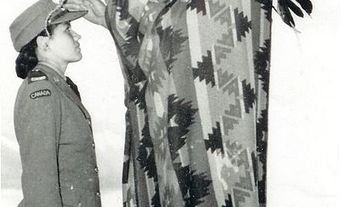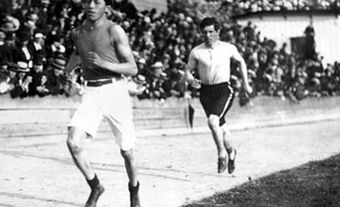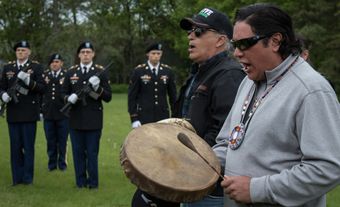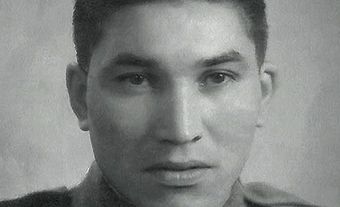David Georges Greyeyes-Steele, Plains Cree farmer, multi-sport athlete, soldier, war hero, First Nation chief, federal public servant (born 31 December 1914 on Muskeg Lake Cree Nation, SK; died 22 July 1996 in Saskatoon, SK). Greyeyes-Steele served in the Canadian Army during the Second World War and was awarded the Greek War Cross.

David Greyeyes-Steele, Canadian Army (1944).
Early Life
Between 1922 and 1933, David Greyeyes-Steele attended the Lebret Industrial Residential School, where he studied agriculture. (See also Residential Schools in Canada.) After school, he grew grain at Muskeg Lake and worked in northern Ontario bush camps.
Second World War
David Greyeyes-Steele enlisted in the Canadian Army in June 1940. Besides two brothers who served, his sister, Mary, was the first Indigenous woman to join the Canadian Forces when she enrolled in the Canadian Army Women’s Corps. Because of his expertise in weapons handling, Greyeyes-Steele became an instructor in a machine-gun reinforcement unit in Britain. Now a sergeant, he instructed soldiers arriving from Canada. After more than two years, Greyeyes-Steele returned to Canada to train at the Officers’ Training Centre (Western Canada) in Gordon Head, near Victoria, British Columbia.
Five months later, Greyeyes-Steele returned to Britain as a lieutenant and was sent to the Saskatoon Light Infantry (Machine Gun) (SLI(MG)). The SLI(MG) was the support battalion for 1st Canadian Infantry Division. After a few reorganizations, the battalion eventually consisted of three machine-gun companies (each with three platoons of four .303 Vickers medium machine guns) and a mortar company of four platoons (each with four 4.2-inch mortars). Both machine guns and mortars were transported in universal carriers: small, lightly armoured, open-topped, fully tracked vehicles.
Lieutenants commanded platoons and Greyeyes-Steele was put in charge of a mortar platoon when he arrived at the battalion. At the time, the unit was engaged in the Italian Campaign, which began with the invasion of Sicily in July 1943 and crossed to the Italian mainland in September.
Third Greek Mountain Brigade
In September 1944, the 3rd Greek Mountain Brigade was assigned to I Canadian Corps to gain battle experience during the Corps’ attack against Rimini, a city on Italy’s Adriatic coast. In the early hours of 14 September, the Greeks moved forward to secure the right flank of a Canadian attack. They had been strengthened by the addition of Canadian anti-tank guns, plus a machine-gun company and the mortar company from the SLI(MG).
As the Canadian attack continued toward Rimini, the Greeks made slow progress against heavy German resistance and lost more than 100 men. Early on 21 September, a Greek patrol reached the southern outskirts of Rimini and the brigade was given permission to enter the city. By 8 a.m., a Greek flag flew over the town hall. David Greyeyes-Steele later recalled the road to Rimini was bleak and “there was quite a lot of destruction.” For his support of the Greek Brigade, he was awarded the Greek War Cross (Third Class), one of only 14 Canadians to receive this medal for heroism during the battle.
When the Italian Campaign ended, Greyeyes-Steele was transferred to Northwest Europe with I Canadian Corps and served in France, Belgium, the Netherlands and Germany. Once Germany was defeated, he volunteered for service in the Pacific, but Japan surrendered before that happened. Instead, he remained with the Canadian Army Occupation Force in Germany as an intelligence officer for the Royal Winnipeg Rifles until his return to Canada.
Athletics
David Greyeyes-Steele played hockey, softball and soccer. It was in the latter sport he excelled and was chosen three times for the Saskatchewan All-Star soccer team. As a member of that team, he played against three English clubs in 1937, 1938 and 1949. While serving in Europe, he was a member of the Canadian Team that won the Overseas Army Championship and played in Inter-Allied Games in 1946.
Post-War Life
David Greyeyes-Steele returned to the Muskeg Lake Cree Nation after the war and took up grain farming again. He married fellow veteran Flora Jeanne, one of the first Indigenous women to join the Royal Canadian Air Force Women’s Division. In 1958, he became chief of his First Nation.
Two years later, Greyeyes-Steele began a 15-year career with the federal public service in what was then the Indian Affairs Branch of the Department of Citizenship and Immigration. (See also Federal Departments of Indigenous and Northern Affairs.) Greyeyes-Steele became director of the Maritime, Alberta and Saskatchewan regions of the department, the first Indigenous person in Canada to be appointed a regional director. He retired in 1975.
About 21 years after his death, in 2017, Greyeyes-Steele Way in The Meadows housing development in southeastern Saskatoon was named after him.
Honours and Awards
Saskatchewan Sports Hall of Fame (1977)
Member of the Order of Canada (1977)
Saskatchewan Order of Merit (1993)
Saskatchewan First Nations Sports Hall of Fame (1994)

 Share on Facebook
Share on Facebook Share on X
Share on X Share by Email
Share by Email Share on Google Classroom
Share on Google Classroom






